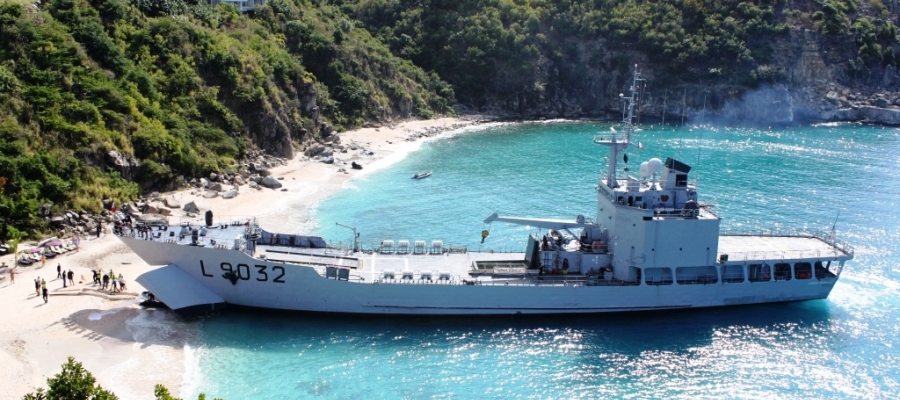Discovered by Columbus in 1493, and named for his brother Bartolomeo, St. Barths was first settled in 1648 by French colonists from the nearby island of St. Kitts.This original settlement was not a grand success, and, in 1651, the island was sold to the Knights of Malta.
Discovered by Columbus in 1493, and named for his brother Bartolomeo, St. Barths was first settled in 1648 by French colonists from the nearby island of St. Kitts.This original settlement was not a grand success, and, in 1651, the island was sold to the Knights of Malta.
Five years later, a raid by angry Carib Indians destroyed the settlement killing all the settlers. The victim’s heads were placed on poles lining Lorient beach to discourage prowlers.
In 1763, the island was settled again, this time by French mariners from Normandy and Brittany. This colony succeeded. French buccaneers found the place hospitable, and brightened the economy with vast quantities of plunder taken from Spanish galleons. Monbars the Exterminator, a famous buccaneer of noble French descent, reputedly maintained his headquarters in St. Barths. His treasure is believed to be still hidden among the coves of Anse du Gouverneur, or buried in the sands of Saline.
Gradually the buccaneers became tradesmen, shopkeepers, fishermen, and small farmers. The island was too small, too rocky, and too dry to become part of the sugar economy of the larger islands.
Except for a brief military takeover by the British in 1758, St. Barths remained French until 1784, when it was sold suddenly to Sweden by one of Louis XVI’s ministers in exchange for trading rights in the Swedish port of Gothenburg.
As a free port under Swedish rule, St. Barths served the useful purpose of providing a trade and supply center for the various factions of the colonial wars of the 18th century. When a sea captain captured a prize or raided a settlement, he could sell the booty in St. Barths, and at the same time resupply his ship. Overflowing warehouses surrounded a harbor packed with ships from many nations, and a mercantile tradition was established that has lingered to the present day. This period of prosperity was short-lived, however, as conflicts ended, and sailing ships were replaced with motor vessels.
France repurchased the island in 1878. The free port status remained, and does to this day, along with such Swedish mementoes as bits of architecture, a cemetery, a few street signs, and, of course, the name of the harbor and capital, Gustavia.
In 1946, Martinique and Guadeloupe, including St. Barths, were given the legal status of a Department of France with the same privileges and responsibilities as any of the Home Departments. This is analogous to the Americans conferring statehood upon Hawaii. The citizens were given French passports, and were expected to pay French taxes, and obey laws formulated in Paris. A Black baby, a descendant of slaves, born in a thatched hut beneath swaying palm trees of Guadeloupe, suddenly became just as French as Cyrano de Bergerac.
In 1957, American millionaire David Rockefeller bought a property: the notoriety of the island quickly grew and its transformation as an upscale tourist destination was underway.
In 1967, Britain cut loose most of their Caribbean dependencies because they had become a losing proposition, and were likely to remain so. Sugar is no longer a profitable product, and growing populations require more and more public services that local revenues cannot support. During that same year, France increased the amount of money sent to its islands, and has every year since.
During the last twenty years the resident population of St. Barths has more than doubled. Fewer natives are leaving, and growing number of outsiders are arriving to make an island home for themselves, especially from Metropolitan France.
In the past, outsiders came to St. Barths as a refuge. They valued privacy and detachment, and found differences of culture a welcome barrier to unwanted familiarity. They were interesting people, often eccentric, and preferred simplicity and meagerness to the hazards and resources of the wider world. Two local hotels, Eden Rock and Les Castelets, were designed and built by members of this vanishing breed.
Over the past 10 years, the islands of Saint Barthélemy and Saint Martin engaged in a process of political evolution that came to fruition on February 2007 with adoption of a new status, and the new Overseas Collectivity of Saint Barthélemy was born on July 15, 2007 and its first territorial council was elected. The 19 members elected Bruno Magras as the first president of the island council.
Today most newcomers arrive in search of opportunity, lured by descriptions in the popular press of a tax-free tropical paradise where well-heeled vacationing fools shower money on every uplifted palm. Most are doomed to disappointment. Living in St. Barths is easy; making a living is not, especially for the non-native.
